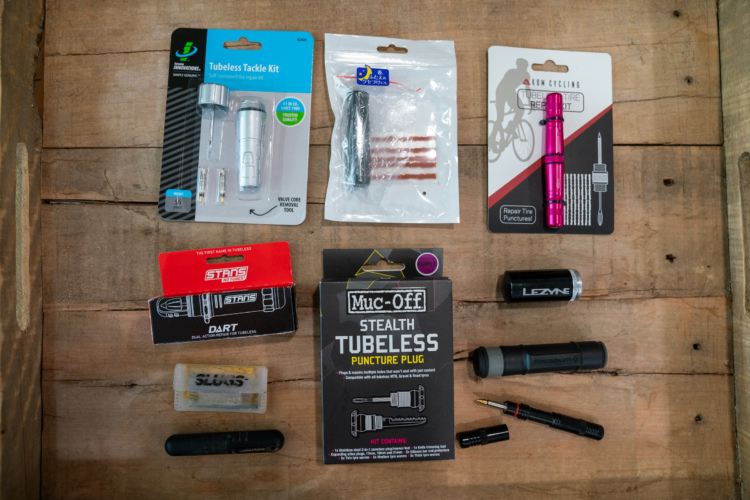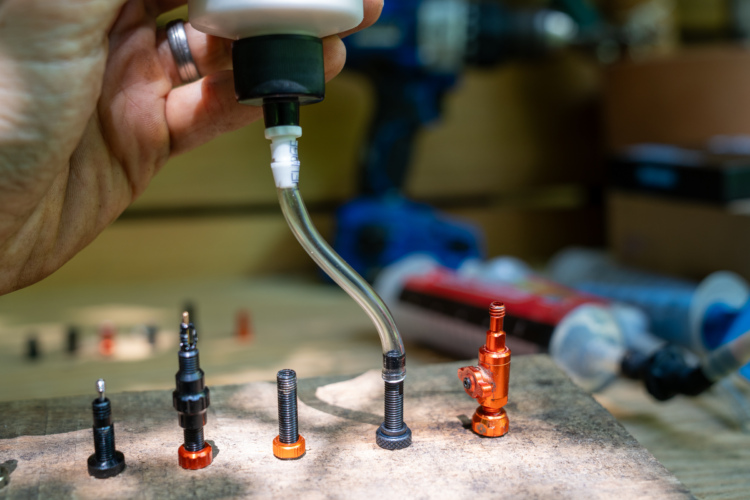
You’ve probably seen Slime on the shelf at your local big box department store. The bright green liquid promises to reduce the chance of punctures, from bike tubes to tractor tires. Notice I said bike tubes; look carefully at the bottle on the shelf at your local Walmart or REI, and you’ll notice it’s probably labeled tube sealant. Slime even sells tubes with sealant inside, but finding a Slime product designed specifically for tubeless bike tires can be difficult.
I’ve tested more than a dozen tubeless tire sealants over the years, so I was curious to see how the new Slime Tubeless Bicycle Tire Sealant compares. Based on my experience with the neon-green goo, it’s every bit as good as the others on the market, thanks to a tried and true formula.

It’s thicker than Stans and Orange Seal, but runnier than Muc Off sealant
I would describe the consistency of Slime Tubeless Bicycle Tire Sealant as medium-thick. It’s certainly thicker than Stans and Orange Seal, but not as thick as Muc Off. Perhaps the closest comparison is Finish Line Fiberlink, though the Slime sealant doesn’t have fancy Kevlar fibers floating around inside.

Singletracks readers have been using Slime tire sealant for years, though this appears to be a new formulation. Slime has marketed a general-purpose tire sealant in the past that they say can be used for bike tires. That stuff is much thicker and has visible bits of black rubber suspended in the liquid, as you can see in the photo above.

The new (newer?) Slime Tubeless Bicycle Tire Sealant isn’t nearly as thick as the general-purpose stuff, which allows it to move around inside the tire a bit more to find punctures and seal them quickly. Though thicker sealants form a nice sticky coating inside the tire, I’ve found you need to use more of it to provide decent protection. Slime recommends about 4-5oz for a typical 29er tire, which is on par with others on the market. The liquid is said to seal punctures up to a quarter inch in size.

Another problem with the thick general-purpose Slime is that it’s difficult to slurp and dispense using a tubeless sealant syringe. The new bike-specific sealant is much more syringe- and valve-friendly, and is easier to clean up, too. The instructions suggest using the flip top to pour/squirt the liquid into the tire before seating it, though I find it easier to inject the sealant through the valve.
Tire sealant recipes tend to be closely guarded secrets, though most, including Slime, make use of two main ingredients: ammonia and rubber latex. Helpfully, this Slime safety data sheet lists other ingredients too: glycerol, cellulose, alcohols, silicon dioxide, triethanol, quartz, and magnesium oxide. Two of those ingredients — cellulose and quartz/mica — are also used in glitter, so maybe there is something to adding glitter to tire sealant after all! 🙂


No accidental punctures yet 🤞
I’m running Slime Tubeless Bicycle Tire Sealant in a Maxxis Assegai tire, and I haven’t experienced any accidental punctures, knock on wood. Just like in the sealant test I conducted a few years ago, I poked a hole in the tire with a pick tool to see how quickly the hole would seal. It took about ten seconds of jiggling and rotating the tire, but eventually the hissing stopped. Stans and Orange Seal typically work a bit faster, though ten seconds is on par with what I’ve found for sealants of similar thickness, like the ones from Finish Line and Muc Off. Just to be safe, I’ll add a little extra sealant to make sure enough of the liquid remains pooled at the bottom of the tire.
Slime Tubeless Bicycle Tire Sealant is blended and bottled in the USA, and can be ordered online from Amazon and Walmart. It’s priced at $8.96 for an 8oz bottle, which should almost cover two MTB tires, give or take. That’s much cheaper than Orange Seal, though only a bit cheaper than an equivalent volume of Stans or Muc Off sealant.











5 Comments
Jun 1, 2025
Jun 2, 2025
It never coagulates and can be quickly washed out with soap & water.
Jun 5, 2025
Jun 2, 2025
May 31, 2025